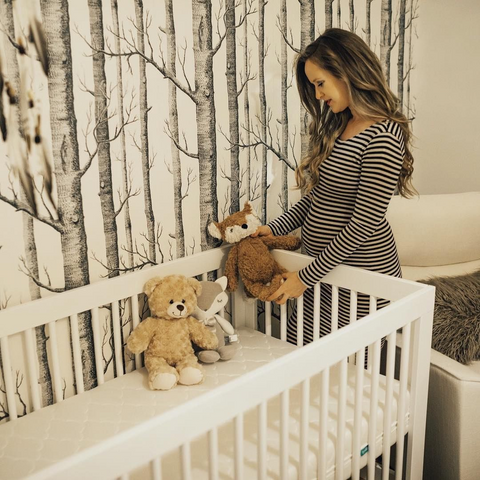
Preparing a nursery for a new little one is fun but not always straightforward! In addition to decisions about decorations and paint color, you’re also trying to figure out how to make the nursery a safe place for your baby. Using a non-toxic crib mattress can be part of that.
Up until now, you might not have ever thought twice about crib mattresses. And now you’re wondering if you should buy a non-toxic crib mattress for your precious baby. What’s all the fuss about anyway?
Newton Baby is here to give you the scoop on what makes a crib mattress toxic and how you can choose a non-toxic option for your baby’s crib.
Let’s start with why this matters. Then, we’ll move on to how to choose a non-toxic mattress and other ways to make your home environment safe.
Why A Non-Toxic Crib Mattress Is Important
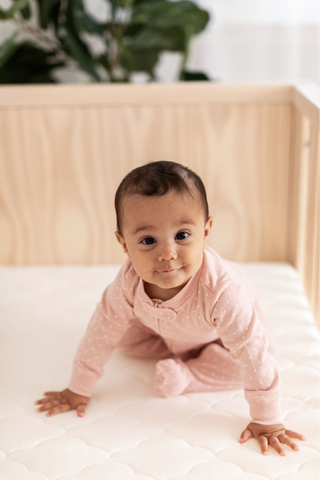
It might seem like a mattress is a mattress, but not all crib mattresses are created equal! If you’ve heard a lot of talk about non-toxic crib mattresses, it’s for good reason. Having one is important in a few ways.
1) Traditional Mattresses Release Chemicals
You might not think that crib mattresses harbor all sorts of harmful chemicals, but they can. How exactly can crib mattress chemicals harm your baby? Good question.
The chemicals in a mattress don’t just sit there. The real problem is that traditional crib mattresses release volatile organic compounds (VOCs) and other chemicals into the air through a process called off-gassing.
Off-gassing happens when the chemicals used in certain materials (or in the process of making those materials) leak into the surrounding air. Most people believe that off-gassing is linked to harmful smells or odors in the air, but this is not always the case.
Not all chemicals have a scent when they off-gas, and not all items with a scent are off-gassing. This means many items in your home — including your baby’s mattress — might be off-gassing without you even realizing it.
These airborne chemicals are no joke. They aren’t just bad-smelling or annoying allergens. They can cause respiratory irritation, nervous-system damage, endocrine disruption, and possibly even cancer.
2) Heat Increases Chemical Emissions
It’s concerning enough that your baby’s crib mattress could be releasing toxic chemicals into the air. But what’s even more worrisome is this: while off-gassing happens at room temperature, heat increases emission even more.
Yes, that includes body heat. Your little one might not be very big, but their body on the mattress produces enough heat to increase off-gassing.
That means there are even more chemicals swirling around in the air that your baby breathes while they sleep.
3) Your Baby Spends A Lot Of Time Sleeping
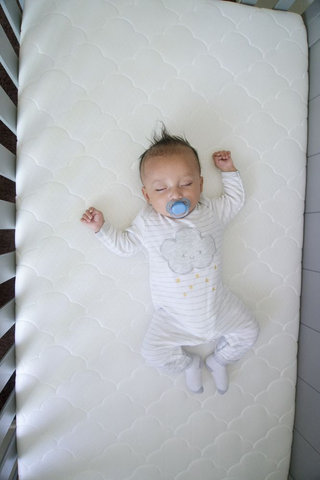
Your baby is especially vulnerable to the toxic chemicals released from a mattress not only because they’re tiny and developing, but also because they spend so much time sleeping!
Between naps and nighttime, your little one spends a lot of time in their crib. That’s exactly as it should be, but it means that they have more exposure to the off-gassing from their mattress.
It also means that your baby’s crib should be a safe place for them to spend time alone. So, in addition to providing them with a non-toxic crib mattress, be sure to follow sleep safety guidelines.
Without going into too much detail, here are a few of them.
Use A Firm Sleep Surface
A soft, fluffy bed might be cozy to you, but it isn’t safe for your baby. Firm, yet comfortable is best when it comes to your little one’s mattress. And it should bounce right back when you press on it.
Keep The Crib Bare
For the safest sleep, your baby should sleep in a bare crib. The mattress, a top sheet, and your little one are the only things that should be inside — no baby pillows, crib bumpers, blankets, toys, or stuffed animals.
If you’re dying to decorate their crib, opt for a patterned fitted sheet to give you that touch of adorable whimsy. All the other decorations should be saved for outside of your baby’s bed.
Share Your Room, Not Your Bed
The American Academy of Pediatrics recommends that you share your room, but not your bed, for at least the first six months of your baby’s life. That means you should keep your baby’s crib, bassinet, or cradle in your room near your bed.
Put Your Baby On Their Back
Although your baby should have plenty of tummy time during their waking hours, the safest way for them to sleep is on their back, not their side or stomach.
What if your baby has learned to roll over all by themselves? Continue to put them to sleep on their back, but don’t worry about tip-toeing into the nursery to turn them over if they roll during the night.
When they’re able to show off this skill, they’ve developed the necessary muscles to keep themselves safe.
Offer A Pacifier
A pacifier for safe sleep? Yep. The American Academy of Pediatrics says that allowing your baby to use a paci while they snooze can promote safe sleep.
Simply wait until your newborn has a good handle on breastfeeding, then start offering your wee one a pacifier for naps and nighttime.
Keep in mind that there’s no need to force it if your baby isn’t interested, and it’s not necessary to go into the nursery to replace the pacifier if it falls out of their mouth during the night.
While we kept our list brief in this article, you can always read more safe sleep tips here.
Now, back to why a non-toxic crib mattress is important.
4) Organic Isn’t Enough
A crib mattress made with “organic” material sounds great. Easy decision to make, right? Not so fast.
The problem is that an organic label doesn’t guarantee that all of the materials used to make the mattress are organic. Sadly, a crib mattress marketed as “organic” is not necessarily non-toxic — although some are — and can still expose your baby to a slew of chemicals.
This is another reason looking for a non-toxic mattress is important.
What Makes A Crib Mattress Toxic

Mattresses seem like soft, non-threatening places to lie down for a little shut-eye, but as we’ve seen, that’s not necessarily the case. So, what is under the surface that makes them dangerous?
Polyurethane Foam
This is a common filler for crib mattresses. But polyurethane foam comes from petroleum and is loaded with chemicals you don’t want your baby to breathe.
There are healthier-sounding options — like soy foam or plant-based foam — but they’re not much better than polyurethane foam and can still be full of chemicals.
Polyurethane foam is also flammable, but the good news is that the powers-that-be require all crib mattresses meet a certain flame-resistant standard. Well, that’s kind of good news...
Flame-Retardant Chemicals
A mattress that won’t burst into flames is a good thing!
But the flame-retardant chemicals (PBDEs are a common one) typically used to make a mattress flame-resistant are linked to some pretty negative effects, like hormone disruption, cancer, and developmental and neurological problems.
Vinyl (PVC)
Vinyl (polyvinyl chloride or PVC) is often used to make a mattress waterproof. And any parent knows that waterproof material comes in handy when dealing with spit-up, blowouts, and the like!
But (you can probably guess what’s coming here) vinyl is one of the most toxic plastics out there. To make matters worse, phthalates are added to soften hard vinyl.
This toxic plastic and the phthalates involved can lead to endocrine disruption, cancer, and respiratory problems.
How To Choose A Non-Toxic Crib Mattress
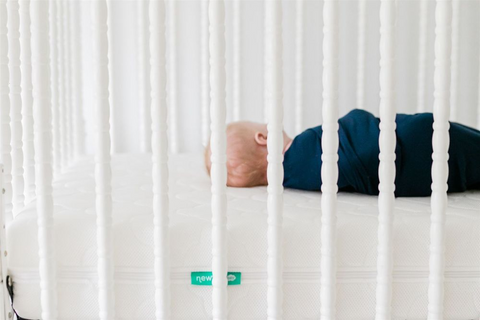
So, what’s a parent to do? Choosing a non-toxic mattress might not be as hard as you think. You just need to know what to look for. And that’s what we’re here to tell you!
We’ll give you four tips for choosing a non-toxic crib mattress for your baby so you can have peace of mind while they snooze!
Plus, when it comes to non-toxic crib mattresses, we’re pretty proud of how our Newton Baby Crib Mattress stacks up, and we’ll tell you why. Keep in mind that our Crib Mattress comes in both mini and standard sizes to suit your needs.
1) Choose A Crib Mattress That’s Greenguard Gold Certified
The Greenguard Certification Program tests the chemical emission of a mattress. This makes it easier for you as a buyer to know which crib mattresses are safe for your baby and which ones aren’t.
There are two levels of the Greenguard certification: the Greenguard Certification and Greenguard Gold Certification.
The standards for the Greenguard Gold Certification are among the most rigorous in the world to test for the lowest measurements of chemical emissions such as VOCs. That’s the certification you want to look for.
Are Newton Baby Crib Mattresses Greenguard Gold certified? You bet they are!
In fact, our mattresses aren’t our only products that are certified. Newton Baby’s mattresses, covers, and mattress pads have all been independently tested and certified to meet Greenguard Gold standards for the lowest chemical emissions.
2) Stay Away From Polyurethane Foam
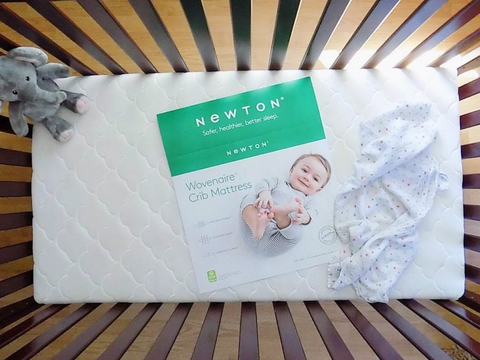
As far as the mattress filler goes, stay away from polyurethane foam. Instead, we think the best option is a special material called Wovenaire®.
Wovenaire® is a patented cushioning material that replaces foam, latex, and springs and is the core of all Newton Baby mattresses. It’s made of 100% recyclable food-grade polymer, an LDPE grade 4 plastic. It’s the same material as a yogurt container!
Wovenaire is 90% air by volume, making it incredibly light and airy yet firm enough to provide your little one with safe sleep. And, of course, it’s hypoallergenic and doesn’t leach toxic chemicals.
How is this unusual (and unusually wonderful) material made? By weaving the polymer in a pool of crystal-clear water. During this process, it solidifies to form a three-dimensional cushion before it is shaped into crib mattress sizes.
3) Find A Mattress Without Flame Retardant Chemicals
For a non-toxic crib mattress, say no to mattresses soaked with harmful, flame-retardant chemicals. How can you find a mattress that is still fire-resistant?
When creating the Newton Baby Crib Mattress, we opted out of toxic fire-retardant chemicals. Instead, we use a material called viscose: a natural, chemical-free approach for exceeding rigorous federal flammability standards. This encasement is removable, fully breathable and machine washable.
This is a completely safe, halogen- and heavy metal-free solution for achieving the fire safety standards that are required by the US government.
4) Avoid Vinyl
There’s nothing wrong with wanting a waterproof mattress or mattress pad. That protection can come in handy for spit-up, diaper leaks, or accidents during the potty training years! Just be sure to avoid vinyl as a waterproofing material.
For safe waterproof protection, consider the Newton Baby Waterproof Crib Mattress. It offers a 2-stage design with our classic breathe-thru cover on the infant side and an added layer of TPU waterproofing on the other side, making it perfect for the toddler years.
We also offer a breathable and waterproof crib mattress pad to keep the breathability and comfort that you love from the Newton Baby mattress while adding waterproof protection for quicker cleanups.
The good news is that even if a mess leaks down into the mattress, our mattresses themselves are washable from cover to core, so you never have to worry about mold or bacteria!
The washing process is also incredibly simple. First, unzip and remove the cover, which can be washed on cold with mild detergent and dried on low heat.
Then, to wash the mattress core, place it in the shower or tub and spot-clean or wash the whole thing with cool water and mild detergent or vinegar. You can also rinse it outside with a hose if this is easier.
After the mattress is all squeaky clean, simply shake the water out and let the mattress air-dry. It’s as easy as that!

More Non-Toxic Nursery Options
If you’re jumping onto the non-toxic crib mattress train, welcome aboard! To make your baby’s entire environment as non-toxic as possible, don’t forget about other nursery items, such as the crib, crib sheets, and the like.
There are three options we think you’ll love: organic crib sheets, organic swaddles, and a GREENGUARD Certified crib. We’ll also give you a few other general tips to create a non-toxic environment in your home.
Organic Cotton Sheets

For crib sheets that are certified to the Global Organic Textile Standards, turn to our Organic Cotton Sheets. They’re made with supremely soft, pre-shrunk, organic cotton muslin that’s hypoallergenic and machine-washable for the most hygienic sleep surface.
These sheets are also 100% breathable, providing superior airflow to keep your baby comfy, cozy, and safe all night. Pair them with our Crib Mattress for even more breathability.
Even if you don’t have a Newton Baby Crib Mattress, you can still choose these sheets for your nursery. They come in both standard and mini sizes, and the all-around elastic guarantees a safe, snug fit for any crib mattress.
To care for these organic sheets, wash with warm water and like colors, and then tumble dry on low.
Organic Swaddles
Another organic option, our Organic Swaddle Blankets are almost as good as being held! Ultra-soft and cushy, these swaddles are 100% breathable to help keep your baby at the perfect temperature and avoid overheating.
Just like our crib sheets, they’re hypoallergenic and made with organic cotton muslin certified to the Global Organic Textile Standards.
The other great thing about these swaddle blankets is that they are versatile — we know how important that is for parents! Use these swaddles not only for wrapping your baby but also as a changing pad, breastfeeding cover, burp cloth, or tummy time mat.
These swaddles are machine washable with warm water and can be tumble-dried.
If you’ve read this far and aren’t sure how to go about swaddling your infant or why you’d want to, we’ll just say this: Swaddling offers several benefits such as calming your baby’s startle reflex, regulating body temperature, and promoting better sleep. Sounds good, right?
Swaddling is also probably easier than you think. For tips on swaddling and a video on how to do it, click here.
Convertible Crib

Another GREENGUARD Gold Certified and non-toxic baby product, our Convertible Cribs offer style, years of longevity, and easy conversion.
Created from soft wood by skilled artisans in Italy, this fine craftsmanship means your baby’s crib will come with quality construction, attention to detail, and timeless style.
These cribs are made by hand and ethically constructed in a woodworking shop with a reputation for building quality wood furniture since 1932.
Though they’re crafted in Italy, these cribs are made to exceed United States standards with durable, sustainably farmed solid FSC beech wood and non-toxic finishes. Rest assured that they meet or exceed JPMA and Federal safety standards.
In addition to quality construction, the 3-in-1 crib also grows with your baby, offering three adjustable mattress heights. Then, right before your adventurous little one is ready to climb out of their crib, it easily converts to a toddler or day bed.
With this crib option, you can take your nursery design into account and choose from three designs: the Austin, Soho, or Domino.
Create A Non-Toxic Environment

As promised, we’ll wrap up this article with a few general tips to help create a non-toxic environment by reducing chemicals, VOCs, and off-gassing.
We’ve already talked about how to choose a non-toxic crib mattress and other baby items. But here are a few additional tips you’ll find helpful.
Use Natural And Non-Toxic Everyday Products
To reduce toxins in your home, opt for natural and non-toxic everyday products. For example, choose cleaning products with natural ingredients or turn to options like vinegar, baking soda, and lemons to get the job done.
And when it comes to decorating your baby’s nursery, choose a low VOC paint to deck out the walls.
Buy Used Items
There are certain baby items that are always better to buy new — the car seat, crib mattress, and breast pump. With other baby items, if you want to choose used or hand-me-down items, go right ahead.
In addition to being easy on the wallet, used items can reduce the amount of chemicals that you bring into your home since they’ve already off-gassed some.
Take Advantage Of Fresh Air
For brand new, non-GREENGUARD Certified products that may off-gas in your home, leave them outside, in the garage, or in a well-ventilated spare room for a few days. This way, your family won’t be as affected by the chemicals of the first few days of off-gassing.
Choose fresh air as often as possible. In addition to letting fresh air in on an average day, it’s a good idea to open the windows in your house when you’re painting or cleaning to prevent chemical build-up.
Install Smoke Detectors And Carbon Monoxide Alarms
You can detect smoke with your nose, but there are some odorless gases and chemicals that you can’t sniff out.
In addition to smoke detectors, install carbon monoxide alarms throughout your home to alert you in the case of a high concentration of this gas.
Opt For Hardwood
If you’re building your home from the ground up or remodeling, ditch the carpet and go with hardwood floors.
While carpet can be cleaned and sanitized, it’s much more difficult to do away with bacteria in this material than on hardwood floors. Plus, hardwood is better for indoor air quality.
Safety For Your Baby And Peace Of Mind For You
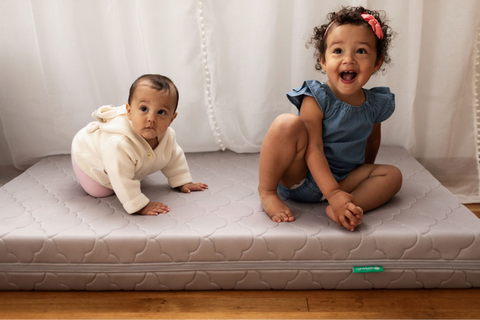
There’s a lot to think about when raising a baby, and their health and safety is on the top of that list. Now that you have the low-down on non-toxic crib mattresses, you’re ready to choose a mattress that will provide your little one with night after night of safe sleep.
Not all decisions about baby products are easy, but this one is! Go with the breathable, washable, non-toxic Newton Baby Crib Mattress, and you’ll have peace of mind knowing that your baby isn’t breathing toxic chemicals from their mattress.
Take it a step further with other non-toxic nursery options, such as our Organic Swaddle Blankets, Organic Cotton Sheets, and GREENGUARD Certified Convertible Cribs.
Sleep tight, little one!